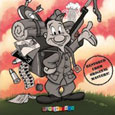Famous Studios/Paramount (1944-1950), Thunderbean (2012), 1 Disc, 150 mins, 4:3 ratio, Dolby Digital Mono, Not Rated, Retail: $15.95
Storyboard:
Famous Studios came out of the ashes of a studio that was once Disney’s greatest competitor. These cartoon shorts represent the best of their output, including a number of one-shots, plus a few ongoing character series.

The Sweatbox Review:
1942 was a dark time for many reasons, but in many ways it was still a golden age for the entertainment industry. Comic books and newspaper strips, movie serials, and theatrical features all flourished; and theatrical animation was still at a peak. Disney was still doing some of its best work, and the MGM and Warner Bros. cartoon studios were entering their best years. However, Disney’s biggest rival from the old days was closing down. 1942 was the year that Max and Dave Fleischer saw their studio get taken away from them. The Fleischers had seen great fame and success from their Betty Boop, Popeye, and Superman series; but their distributor, Paramount, gained the upper hand when the Fleischer’s two features (Gulliver’s Travels and Mr. Bug Goes To Town) under-performed. A costly move to Florida, staff issues, and a rocky relationship between Max and Dave all contributed as well. Paramount was able to assume control of the studio, pushing the Fleischers out, though many staffers remained with the newly christened Famous Studios.

Three top Fleischer men had been put in charge: Sam Buchwald took over the business side from Max, while Isadore Sparber and Seymour Kneitel took over as supervising directors, which was Dave’s old post. This ensured a certain level of professionalism, and kept Famous near the top of the heap in quality. Eventually, the budgets would get reduced and the cartoons would become ever more formulaic; but for a while the Famous cartoons still looked and provoked laughs about as well as the Fleischer cartoons of yore had, minus some of the New York hipness and the surreal edge and inventiveness that had previously distinguished the studio. The studio did move back to New York in 1943, but something had already been lost that was never quite regained. Overall, however, the quality at least remained high for some time.

Superman still got a few more releases, and Popeye went on a good while longer, while Famous sought to forge a new identity. They started with licensing Little Lulu, who got 26 cartoons in the 1940s before being replaced by Famous-owned Little Audrey. Other than that, Famous relied on the Noveltoons (a successor to Fleischer’s Color Classics) series to provide one-shot entertainment, or to be the launch pad for new characters. Out of Noveltoons would come Casper and Baby Huey, but also a number of less-remembered characters. In fact, if not for Steve Stanchfield and his Thunderbean outfit, most of us would have very limited opportunity to view any Noveltoons today. Fortunately, Thunderbean saw fit to gather up a good example of Noveltoons and present them on DVD for cartoon buffs to enjoy.

This disc of Noveltoons Original Classics gathers up twenty long-forgotten cartoons from the heyday of Famous Studios, dating between 1944 and 1950. Assumedly, these are Noveltoons that have fallen into public domain, in-between Paramount selling and buying back some of their cartoons over the years. Even with having to use only legally available shorts, the cartoons here do make up a great set. The budgets on these cartoons were still relatively high, and the Famous ranks were filled with top artists and story men. Rarely do the shorts achieve the surreal heights of the best of the Fleischer stuff, but that does not have to speak against them. This is a different product than Betty Boop, after all. And many would be amazed at how well some of these cartoon hold up today. In fact, it may be a minor revelation.
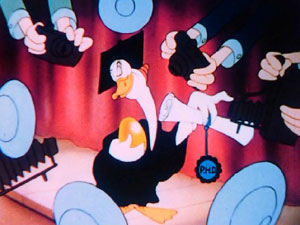
Presented chronologically when using “Play All”, the disc starts with the third Noveltoon, Cilly Goose, a funny cartoon about a goose who tries the old “I laid a golden egg” caper. It’s a charming start to the disc, which only gets better with Suddenly It’s Spring, a whimsical Raggedy Ann short that sees Ann speaking with the weather spirits about improving things on earth to allow a sick little girl to become well again. This is one of the few cartoons on the disc that captures the unique and surreal spirit of the Color Classics, although it is matched by another Ann cartoon called The Enchanted Square. In that one, Ann assists a blind girl to use her imagination and thereby “see” her world in a way many of us would envy.

Many of the shorts are one-off cartoons, like Yankee Doodle Donkey, which is about a donkey who earns his way into the army by pretending to be a dog. But then there are also several attempts at establishing new cartoon stars, like Herman and Henry, an unlikely duo of a mouse and a rooster. The pair are shown in Scrappily Married, demonstrating the foibles of married life. They appear again in Sudden Fried Chicken, involving a boxing match with prize money on the line. Herman (the mouse) also appears in Cheese Burglar, trying to come between dog and cat buddies; and Naughty But Mice and Saved By The Bell, where he helps some country mice with a dangerous cat, Speedy Gonzales style.
Blackie the sheep stars in Lamb In A Jam and Much Ado About Mutton, typical wolf-versus-cute-animals shorts. Then there’s a little black bird named Buzzy, starring in The Stupidstitious Cat— you can probably guess how that one runs by its title.

Leprechauns get two wonderfully imaginative cartoons on the disc, starting with The Wee Men and then Leprechauns Gold. Both are supervised by Bill Tytla, and obviously deal with the Irish myths, in each case having leprechauns going against a greedy human. Flip Flap is an especially charming little short, about a seal living in a zoo, who longs for life on the outside. He finds love in the Arctic, but cannot stay away from danger. The Bored Cuckoo is in a similar vein, though here the hero is truly an outcast, a wooden bird trying to live with real ones.
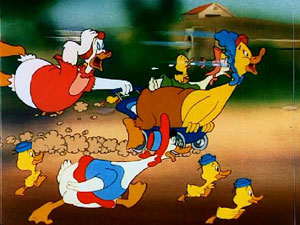
Baby Huey, the giant duckling, makes his first appearance in Quack A Doodle Doo. At first, his size and clumsiness make him despised by the other ducks, but he proves to be their salvation against a fox. Teacher’s Pest stars a little owl named Junior, going up against yet another wolf who sets up a fake school in order to catch him to eat. A lazy horse named Lightning frustrates his jockey’s attempt to win a race in Ups An’ Downs Derby. Sometimes it’s difficult to know how serious the studio was in making a new star, as a hungry lion gets a character card in Pleased To Eat You.
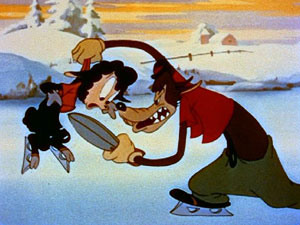
There is not a clunker in the bunch. The Noveltoons presented here are uniformly good, except when they are great. Animation quality is top notch, and each cartoon is a credit to its medium. While many of them are typical funny animal shorts dealing with marriage or pursuit by a predator, every one of these is funny and ranks up there with what the other studios were doing at the time. At their best, the Noveltoons aspired to greatness, such as with the poignant and beautiful Raggedy Ann cartoons. The cartoons on this DVD collectively come from an era in which Famous was doing its best work, and it is lovely that Thunderbean has brought these cartoons to light again. (But speaking of “era”…Parents may wish to note that, as usual for cartoons of this vintage, there is an occasional lapse in what see today as political correctness. Stereotypes involving minorities and gender are present, though not in abundance.)
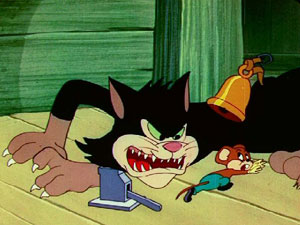
Viewers will find much to make them reconsider Famous as a so-called lesser studio. This DVD helps to re-establish their reputation, and is highly recommended. We cannot imagine an early cartoon buff not wanting to own this disc. This is another great example of what makes Thunderbean the go-to source for vintage animation.
Is This Thing Loaded?
Thunderbean put together a small but impressive selection of bonus features, starting with a Model Sheets Gallery, with over a dozen images.

And, as much as we are glad to see these cartoons get their original titles on the set, it is also interesting to catch a glimpse of how they appeared on television once they were sold into syndication. As such, it is nice to see Television Titles (3:22), narrated by Jerry Beck, who describes how nice it is to see proper prints rather than the faded TV prints glimpsed here.

Thunderbean even managed to locate Noveltoons Title Art, including cels and color keys.
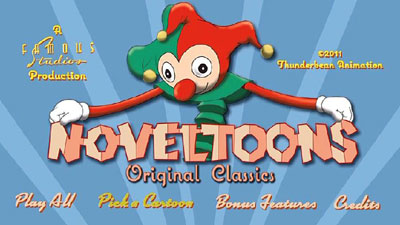
Six cartoons get Audio Commentaries, by such esteemed animation historians as Jerry beck and Thad Komorowski. The commentaries provide much-needed historical context and information, well worth a listen. There are also three Comic Book Stories based on the Noveltoons shorts, one drawn by the legendary Walt Kelly. Publicity Materials contains stills of posters and photos from the shorts, as well as trade articles.
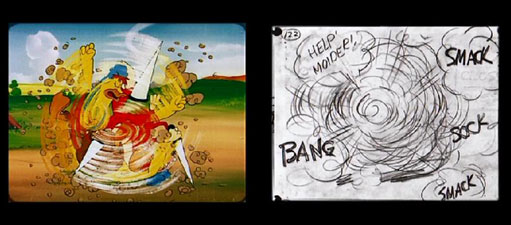
Storyboard Comparison (6:45) looks at original storyboards for the baby Huey short, taken from Photostats, and sets them next to the final film.
Case Study:
Standard keepcase, no inserts. Too bad— Thunderbean’s liner notes can be very informative when they appear.

Ink And Paint:
When I began watching the disc from the beginning with Cilly Goose, I was a little disappointed that the print looked reddish, whites were blown out enough to obscure outlines, and overall the image was quite soft. I figured, “Oh, well. What do you expect of a public domain compilation?” But things got much better in a hurry. It’s still fairly easy to guess which prints were 16mm rather than 35mm, but with Suddenly It’s Spring things settle down well, as that print is much sharper and with better color delineation. Thank goodness, too, because it’s one of the most gorgeous cartoons on the disc. Raggedy Ann’s other cartoon, later on the disc, looks even better (and even better yet on a Blu-ray that Thunderbean produced in 2014). Together, they represent the closest Famous came to the level of Disney’s Silly Symphonies in terms of color use and sentimentality.
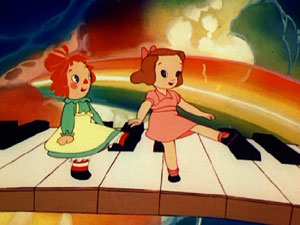
By the time The Stupidstitious Cat came up, I was at ease. That cartoon is especially sharp with only minor print damage. Things stay pretty good until the softer Flip Flap and Ups An’ Downs Derby, though the prints are at least still pretty good overall. In most cases, the prints are of good quality, though one must be ready to forgive print damage, mostly in the form of scratches or projector wear. Until Paramount decides to do their own restorations, this is as good as what is possible.
Scratch Tracks:
Sound is obviously in English mono. Quality varies with each cartoon, but none are hard to listen to. Naturally, there is some faint hiss in places, and minor muffling is noted, but overall any reasonable person would have to be pleased.
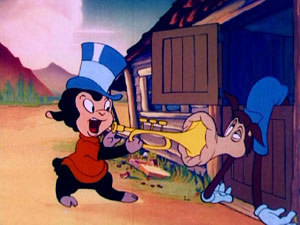
Final Cut:
Anyone who grew up watching faded prints on TV, or has only ever seen the later, cheaper Famous shorts could be forgiven for thinking that Famous was a lesser studio. However, this disc should bring anyone around to realizing that Famous had the goods in its early days, producing funny and beautiful cartoons that carried on the Fleischer legacy. Thunderbean has given us 20 of the best, with variable but overall good 35mm and 16mm prints, looking and sounding as good as they can. That already makes the disc essential, but the bonus features top it all off, making it a great package for vintage cartoon fans.
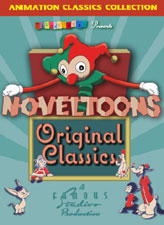 | ||
 |








